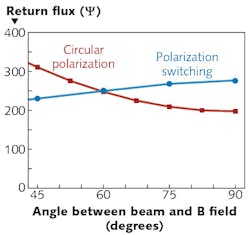Polarization switching improves laser guide star brightness

An artificial laser guide star (LGS) generated by illuminating the mesosphere at 90 km altitude with a 589 nm laser to excite a sodium atom layer is a critical process for astronomical adaptive optics (AO) applications. The artificial beacon, placed in the vicinity of an astronomical object being studied, is subject to similar atmospheric perturbations and offers a route to AO-based image correction. Because improved LGS brightness improves AO outcomes, researchers are using such brightness-boosting techniques as circular polarization, pulsing the laser at the Larmor frequency to mitigate geomagnetic field effects, or, in a simpler method developed by researchers at the Shanghai Institute of Optics and Fine Mechanics (SIOM; Shanghai, China) and the University of the Chinese Academy of Sciences (Beijing, China), polarization switching.
By using a commercially available electro-optic phase modulator and aligning the polarization of the laser at a 45° angle with the optical axis of the electro-optic crystal, applying voltage to the crystal can produce a variable phase delay that alternates between −π/2 and +π/2, switching the laser between left and right circular polarization at the Larmor frequency on the order of 100 kHz. This "magnetically resonant pumping" method uses an optics module that can be retrofitted to any existing or future continuous-wave (CW) LGS laser and can increase return flux at most astronomical observation angles (around 60° to 90°) by as much as 50%. Reference: T. Fan et al., Sci. Rep., 6, 19859 (Jan. 22, 2016).
About the Author

Gail Overton
Senior Editor (2004-2020)
Gail has more than 30 years of engineering, marketing, product management, and editorial experience in the photonics and optical communications industry. Before joining the staff at Laser Focus World in 2004, she held many product management and product marketing roles in the fiber-optics industry, most notably at Hughes (El Segundo, CA), GTE Labs (Waltham, MA), Corning (Corning, NY), Photon Kinetics (Beaverton, OR), and Newport Corporation (Irvine, CA). During her marketing career, Gail published articles in WDM Solutions and Sensors magazine and traveled internationally to conduct product and sales training. Gail received her BS degree in physics, with an emphasis in optics, from San Diego State University in San Diego, CA in May 1986.